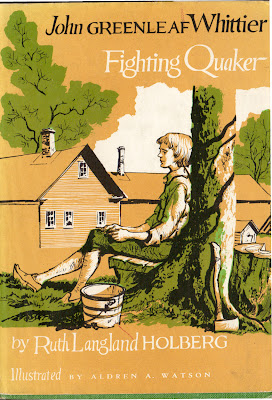We are reading the nostalgic, descriptive poetry of the Quaker poet John Greenleaf Whittier this term. Greenleaf (which is what he went by) was raised on a simple Massachusetts farm and often reminisced in his poetry about farm life. I am taken by his poem, “Telling the Bees”, and am curious as to whether any of you are familiar with this tradition. (Please leave a note!) Here is how Greenleaf describes the practice:
A remarkable custom, brought from the Old Country, formerly prevailed in the rural districts of New England. On the death of a member of the family, the bees were at once informed of the event, and their hives dressed in mourning. This ceremonial was supposed to be necessary to prevent the swarms from leaving their hives and seeking a new home.
Telling the Bees
by John Greenleaf Whittier
Here is the place; right over the hill
Runs the path I took;
You can see the gap in the old wall still,
And the stepping-stones in the shallow brook.
There is the house, with the gate red-barred,
And the poplars tall;
And the barn’s brown length, and the cattle-yard,
And the white horns tossing above the wall.
There are the beehives ranged in the sun;
And down by the brink
Of the brook are her poor flowers, weed-o’errun,
Pansy and daffodil, rose and pink.
A year has gone, as the tortoise goes,
Heavy and slow;
And the same rose blooms, and the same sun glows,
And the same brook sings of a year ago.
There’s the same sweet clover-smell in the breeze;
And the June sun warm
Tangles his wings of fire in the trees,
Setting, as then, over Fernside farm.
I mind me how with a lover’s care
From my Sunday coat
I brushed off the burrs, and smoothed my hair,
And cooled at the brookside my brow and
throat.
Since we parted, a month had passed,–
To love, a year;
Down through the beeches I looked at last
On the little red gate and the well-sweep near.
I can see it all now,–the slantwise rain
Of light through the leaves,
The sundown’s blaze on her window-pane,
The bloom of her roses under the eaves.
Just the same as a month before,–
The house and the trees,
The barn’s brown gable, the vine by the door,–
Nothing changed but the hives of bees.
Before them, under the garden wall,
Forward and back,
Went drearily singing the chore-girl small,
Draping each hive with a shred of black.
Trembling, I listened: the summer sun
Had the chill of snow;
For I knew she was telling the bees of one
Gone on the journey we all must go.
Then I said to myself, “My Mary weeps
For the dead to-day;
Haply her blind old grandsire sleeps
The fret and the pain of his age away.”
But her dog whined low; on the doorway sill,
With his cane to his chin,
The old man sat; and the chore-girl still
Sung to the bees stealing out and in.
And the song she was singing ever since
In my ear sounds on:–
“Stay at home, pretty bees, fly not hence!
Mistress Mary is dead and gone!”
Here is another poet, Deborah Digges, reading her poem by the same name. Listen to the audio!
I have found the most delightful living book to accompany our
enjoyment of Greenleaf’s poetry. The narrations that the students give
are excellent and the story gives such nice background to the poems we are reading. I highly recommend John Greenleaf Whittier – Fighting Quaker by Ruth Langland Holberg








I was moved when watching Lark Rise to Candleford when [name withheld to avoid spoilers!] goes to her hives and says, “Bees, bees, your master is dead. Now you must serve your mistress.” When Queen Elizabeth II died earlier this month and I read about the tradition of Telling the Bees, I realized it was not just a peculiar custom reserved to Lark Rise. Now I have learned this was done in the past here in the States as well. As Michaelangelo so succinctly put it (in his late 80s!), “I am ever learning.”
I love this, Kristyn! Thanks for sharing. I am currently watching Lark Rise so will be looking forward to that scene in particular. I join you in “ever learning”!
I believe it in the final episode of Season 1. ♡
I too read Linnets and Valerians years ago and had to think of it. The bees seemed to be as much people as the people were.
A similar tradition comes up in Linnets & Valerians by Elizabeth Goudge. If I remember correctly, when the children arrive at their uncle's house, they are taken out to be "introduced" to the bees.
Jennifer,
That's cool – I've been meaning to watch that! I watched The Secret Life of Bees (not recommending it, though) and they draped the beehives with large pieces of black fabric to cover them. Thanks for sharing that!
I've never experienced the Telling of the Bees personally, but recently I was watching "Lark Rise to Candleford" (a BBC series based on Flora Thompson's memoirs), and in one scene, the quaint local beekeeper does exactly this when someone died. It was a very touching scene – and your post has made me eager to engage some more with Greenleaf (I have an old book on my shelf with which I will make his acquaintance). Thanks!